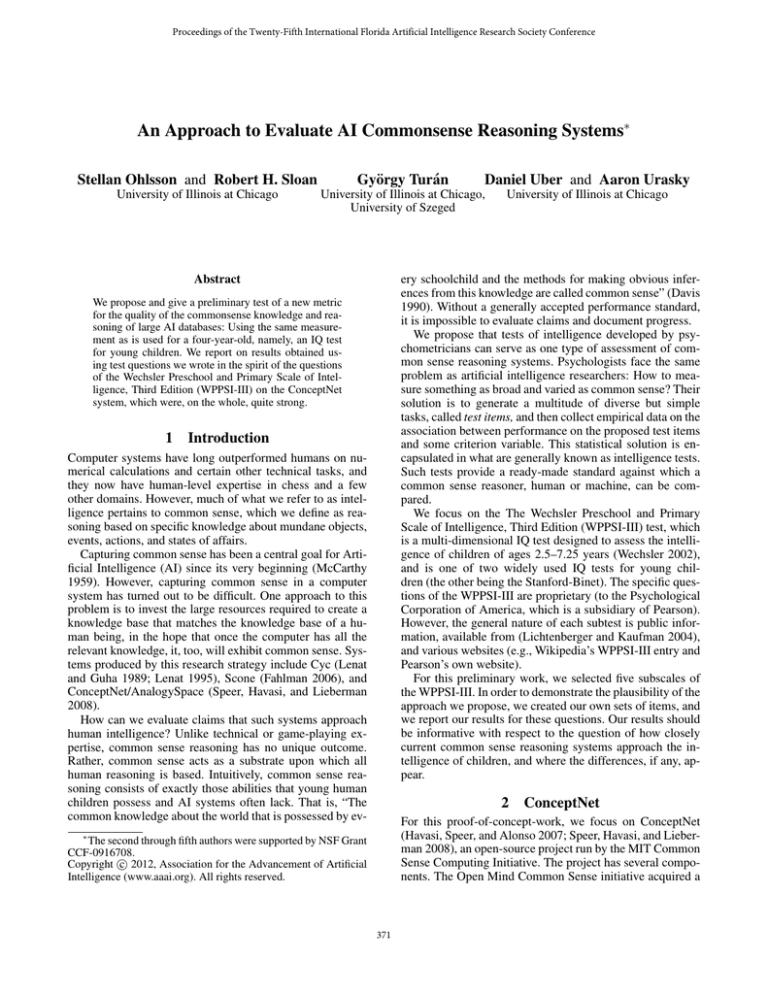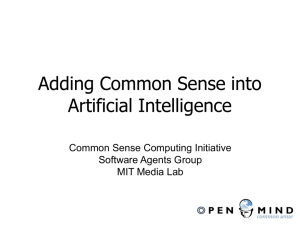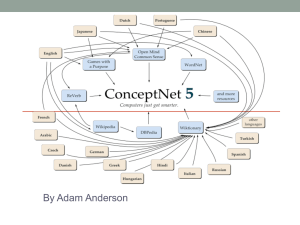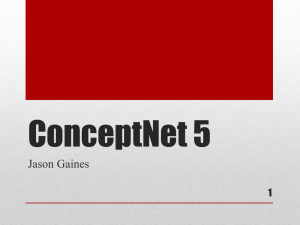
Proceedings of the Twenty-Fifth International Florida Artificial Intelligence Research Society Conference
An Approach to Evaluate AI Commonsense Reasoning Systems∗
Daniel Uber and Aaron Urasky
Stellan Ohlsson and Robert H. Sloan
György Turán
University of Illinois at Chicago
University of Illinois at Chicago,
University of Szeged
Abstract
ery schoolchild and the methods for making obvious inferences from this knowledge are called common sense” (Davis
1990). Without a generally accepted performance standard,
it is impossible to evaluate claims and document progress.
We propose that tests of intelligence developed by psychometricians can serve as one type of assessment of common sense reasoning systems. Psychologists face the same
problem as artificial intelligence researchers: How to measure something as broad and varied as common sense? Their
solution is to generate a multitude of diverse but simple
tasks, called test items, and then collect empirical data on the
association between performance on the proposed test items
and some criterion variable. This statistical solution is encapsulated in what are generally known as intelligence tests.
Such tests provide a ready-made standard against which a
common sense reasoner, human or machine, can be compared.
We focus on the The Wechsler Preschool and Primary
Scale of Intelligence, Third Edition (WPPSI-III) test, which
is a multi-dimensional IQ test designed to assess the intelligence of children of ages 2.5–7.25 years (Wechsler 2002),
and is one of two widely used IQ tests for young children (the other being the Stanford-Binet). The specific questions of the WPPSI-III are proprietary (to the Psychological
Corporation of America, which is a subsidiary of Pearson).
However, the general nature of each subtest is public information, available from (Lichtenberger and Kaufman 2004),
and various websites (e.g., Wikipedia’s WPPSI-III entry and
Pearson’s own website).
For this preliminary work, we selected five subscales of
the WPPSI-III. In order to demonstrate the plausibility of the
approach we propose, we created our own sets of items, and
we report our results for these questions. Our results should
be informative with respect to the question of how closely
current common sense reasoning systems approach the intelligence of children, and where the differences, if any, appear.
We propose and give a preliminary test of a new metric
for the quality of the commonsense knowledge and reasoning of large AI databases: Using the same measurement as is used for a four-year-old, namely, an IQ test
for young children. We report on results obtained using test questions we wrote in the spirit of the questions
of the Wechsler Preschool and Primary Scale of Intelligence, Third Edition (WPPSI-III) on the ConceptNet
system, which were, on the whole, quite strong.
1
University of Illinois at Chicago
Introduction
Computer systems have long outperformed humans on numerical calculations and certain other technical tasks, and
they now have human-level expertise in chess and a few
other domains. However, much of what we refer to as intelligence pertains to common sense, which we define as reasoning based on specific knowledge about mundane objects,
events, actions, and states of affairs.
Capturing common sense has been a central goal for Artificial Intelligence (AI) since its very beginning (McCarthy
1959). However, capturing common sense in a computer
system has turned out to be difficult. One approach to this
problem is to invest the large resources required to create a
knowledge base that matches the knowledge base of a human being, in the hope that once the computer has all the
relevant knowledge, it, too, will exhibit common sense. Systems produced by this research strategy include Cyc (Lenat
and Guha 1989; Lenat 1995), Scone (Fahlman 2006), and
ConceptNet/AnalogySpace (Speer, Havasi, and Lieberman
2008).
How can we evaluate claims that such systems approach
human intelligence? Unlike technical or game-playing expertise, common sense reasoning has no unique outcome.
Rather, common sense acts as a substrate upon which all
human reasoning is based. Intuitively, common sense reasoning consists of exactly those abilities that young human
children possess and AI systems often lack. That is, “The
common knowledge about the world that is possessed by ev-
2
ConceptNet
For this proof-of-concept-work, we focus on ConceptNet
(Havasi, Speer, and Alonso 2007; Speer, Havasi, and Lieberman 2008), an open-source project run by the MIT Common
Sense Computing Initiative. The project has several components. The Open Mind Common Sense initiative acquired a
∗
The second through fifth authors were supported by NSF Grant
CCF-0916708.
c 2012, Association for the Advancement of Artificial
Copyright Intelligence (www.aaai.org). All rights reserved.
371
very large common-sense knowledge base from web users
(Singh 2002). This is ConceptNet itself. AnalogySpace is
a concise version of the knowledge base (Speer, Havasi,
and Lieberman 2008), based on using Principal Component Analysis (PCA) on the large matrix of ConceptNet. We
worked with the tools provided with the ConceptNet 4 release, which include software for working with both ConceptNet and AnalogySpace, and some limited tools for translating between them and natural language.
Both ConceptNet and AnalogySpace work with the same
fixed set of about 20 relations, including IsA, HasA, UsedFor, At Location, and CapableOf; the full list is available in the documentation at http://csc.media.mit.edu/docs/
conceptnet/conceptnet4.html. Each entry in AnalogySpace
consists of two concepts and one of the relations, and a numerical strength.
3
construction of an explanation, and so goes beyond retrieval.
In descriptions of the WPPSI-III, the Comprehension subtest
is often described as being a test of “common sense.”
Our Methodology for Querying ConceptNet
We describe our methodology for querying vocabulary items
in some detail, and then give brief descriptions for the rest
of the subtests, highlighting new issues these subtests raise.
Vocabulary Questions We queried the following words:
Dog, Sun, Running, Happy, Crayon, Airplane, Chair, House,
Baby, Shirt, Silverware, Between, Container, Democracy,
Truth, Painful, Knowledge,Time. We used the following procedure:
1. Use ConceptNet’s natural language tools to map the input
word to a concept in the system.
2. Query AnalogySpace for its top-scoring entry for that
concept that uses one of the relations IsA, HasA,
HasProperty, UsedFor, CapableOf, DefinedAs, MotivatedByGoal, or Causes, restricting to cases where the query
item is on the proper side of the relation.
Description of Work
The WPPSI-III consists of 14 subtests each either core, supplemental, or optional. We chose the five subtests that can
contribute to the Verbal IQ Score: Vocabulary (core), Information (core), Similarities (supplemental), Word Reasoning (core), and Comprehension (supplemental). We created
18 Vocabulary items, 13 Information items, 22 Similarities
items, 10 Word Reasoning items, and 12 Comprehension
items.
3. For the top AnalogySpace item, find the top-scored assertion in ConceptNet using the same pair of concepts (and
typically but not necessarily the same relation).
4. For that ConceptNet assertion, find the top-scored “Raw
Assertion.” Raw assertions are very lightly processed user
inputs from the original Open Mind learning phase.
The Five Subtests We Used
Vocabulary items ask for the meaning of a common word.
For example, the testee might be asked, “What is a house?”
We included a few harder challenges, such as “What is
democracy?” Performance on a vocabulary item requires retrieval of a definition of the given concept, in combination
with a lack of retrieval of irrelevant concept definitions.
Information items ask for the properties, kind, function, or
other aspect of some everyday object, event, or process. For
example, the testee might be asked, “Where can you find a
penguin?” Whereas Vocabulary items request definitional or
meaning information, Information items request the retrieval
of factual information. However, that distinction is not sharp
or precise in terms of human cognitive function.
In a Similarities item, the testee is given two concepts
(words) and asked to relate them. For example, the testee
might be asked, “Finish what I say. Pen and pencil are both
.” Performance on a Similarities item requires the retrieval of the two concept definitions (meanings), and finding a meaningful overlap between them.
In a Word Reasoning item, the testee must identify a concept based on one to three clues given by the tester. For
example, “You can see through it,” and additionally, “It is
square and you can open it.” The processing required by
a Word Reasoning items goes beyond retrieval because the
testee has to integrate the clues and choose among alternative hypotheses.
Finally, in a Comprehension item, the testee is asked to
produce an explanation in response to a why-question. The
testee might be asked, “Why do we keep ice cream in the
freezer?” Performance on a comprehension item requires the
5. Finally, apply a ConceptNet natural language function to
translate that raw assertion back into English.
In the case of dog, the top entry from AnalogySpace
we get in Step 2 relates dog to pet. In Step 3, we find
that the top ConceptNet assertion for dog and pet is
<Assertion: IsA(dog, pet)[]>. Next, in Step 4,
we find the top raw assertion underlying the assertion
IsA(dog, pet) is [(’dogs’ IsA ’pet’). Finally, in
Step 5, ConceptNet’s natural language tools translate that
raw assertion into the sentence, “Dogs are a type of pet.” As
examples of the final answers, our top three results in order, best to worst for dog were: (1) dogs are a type of pet,
(2) dogs can be friendly, and (3) dogs can swim. For happy
we obtained (1) happy is when you feel good, (2) happy
has joy, and (3) if you want to celebrate then you should
be happy.
Information, Comprehension, and Word Reasoning
For both Information and Comprehension we use exactly the
same procedure, and our input is the entire natural language
question, such as “What color is the sky?”
We feed the question into ConceptNet’s natural language
tools, which remove common stop words and return a set
of ConceptNet concepts. We then create an AnalogySpace
category from those concepts, which is effectively a column
vector of concepts, and take the product of the entire AnalogySpace matrix and that column vector to get a vector of
proposed answers. We return the top-scoring answer, with
some restrictions, such as if the first word of the input question was one of the W-question words what, where, or why,
372
processes. Finally, Comprehension requires some constructive, explanatory processing. Figure 1 shows the strict and
relaxed proportional scores for the system for each subtests.
As Figure 1 shows, we see only some of the expected performance decrement as a function of item complexity: ConceptNet does quite well on Information and Word Reasoning, and least well on Comprehension. Interestingly, performance order is the same for both the strict and the relaxed
scoring regimens. Surprisingly, ConceptNet does quite well
on Similarities, and not so well on Vocabulary. To explain
the surprises, we turn to a qualitative analysis of some of the
individual items and how they are handled by ConceptNet.
then we use that word to restrict the set of relations we consider. For example, for where questions, we considered only
the two relations AtLocation and LocatedNear. Otherwise,
we use ConceptNet for question answering precisely as proposed in its documentation and tutorials.
We use essentially the same procedure for Word Reasoning, but with no special treatment of W-question words
(which typically would not occur for these questions anyway).
Similarities For similarities, our inputs are two words,
such as snake and alligator. For each word, we find the concept for the word and its two closest neighbors using the
spreading activation function of AnalogySpace, and for each
of those concepts, we find the 100 highest rated features and
their scores. We create one set for each word, which could
have up to 300 entries, though typically has many fewer because of common entries. We then find the features in the
intersection of the two sets, and return as our answer the
highest scored feature, where we determine score by adding
the score from each set.
Qualitative Observations
Some items elicit multiple sensible or correct answers.
For example, Similarity item “canoe” and “aircraft carrier”
elicited the answers boat (top answer), water, and ocean,
which are all reasonable. However, other items elicited a
mixture of sensible and non-sense answers. For example, Information item “Where does your food go when you swallow it?” yielded both refrigeration (top answer) and stomach. Given that the goal of semantic reasoning systems is to
mimic common sense, answers that are clearly nonsensical
are problematic.
The high 68% strict score on the Similarities subtest may
reflect the fact that abstracting categories is a particular goal
of the AnalogySpace’s use of spectral methods. The relatively low 50% score on Vocabulary items is surprising. Of
course, we may have written relatively more difficult items
for this test. Vocabulary answers were also often difficult to
score: Should “A dog is a pet,” earn one or two points of a
possible two in response to the question “What is a dog?”
We close this section with an example of a wrong answer.
Consider the question, “Why do people shake hands?” from
the Comprehension subtest. The main idea in the list of answers is that people shake hands in order to hold on to the
other person: to hold, to grasp, and to grab were the three
top answers, and numbers four and five stated that playing
the harp and tying ones shoelaces are prerequisites for shaking hands. The notions of friendship, greeting, and respect
were nowhere to be seen.
Scoring
We subjectively scored each answer using the same scales
(either 0–1 or 0–1–2 depending on the subtest) as the
WPPSI-III, which is the only practical thing to do for the
questions we created ourselves for training and development
purposes. For the WPPSI-III, there is an elaborate scoring
manual that gives the score that should be assigned for many
common answers, although the examiner still sometimes has
to use his or her subjective judgment (Lichtenberger and
Kaufman 2004).
To see how heavily the system’s performance was influenced by the relative scores/weights that the system gave to
different concepts, we also performed an alternate scoring
where we assigned the maximum score that any of the system’s five highest weighted responses would have earned.
We call this score relaxed, and the regular score strict.
4
Results of Work
Quantitative Findings
We converted the raw scores into percentage of the maximum score on each subtest, as well as for the average of the
five tests. With the strict scoring method, ConceptNet scored
42 to 68% on the different subtests, with a mean of 56% over
the five subtests. With the relaxed scoring method, its performance rises to a range of 75 to 86%, with a mean of 79%.
Thus there is a large difference in the score as a function
of scoring method. Interestingly, for almost all the questions
where the relaxed score was higher than the strict score, the
higher-scoring answer was the system’s number two or three
answer, not in fourth or fifth place. Under either scoring regiment, ConceptNet is handling a significant proportion of the
items correctly.
The five subtests can be ordered by the depth of processing required. Vocabulary and Information are primarily retrieval tasks, while Similarities and Word Reasoning require
the system to compute the convergence of multiple retrieval
5
Discussion and Conclusions
ConceptNet performed well on the IQ-test type items that
we used. However, this preliminary investigation is limited
in several ways. First, we cannot yet assign ConceptNet an
IQ score, because these preliminary results were obtained
with test items of our own making, and we have no norming
data for these. Second, ConceptNet’s performance may have
been artificially high because the same team was designing
the test questions and the methodology for using ConceptNet to answer them.
A third limitation is that there is some ambiguity at the
input and output ends of this enterprise. A verbal, natural
language test items needs to be translated into the appropriate input for the computer system, and there are choices to
be made that could affect the test score. Similarly, the interpretation of the answers is necessarily somewhat subjective.
373
Figure 1: Results of ConceptNet on each of the five subtests for the items we made up.
A fourth limitation is that we have no baseline performance measure. For example, we do not know what level
of performance could be achieved with latent semantic analysis or other statistical approaches that deliberately refrain
from encoding symbolic content.
In addition to methodological limitations, our investigation uncovered some substantive puzzles. One puzzle is that
the system occasionally returns answers that are more characteristic of technical expertise than of common sense, let
alone the sense of a four-year old, such as the “mammal”
meaning for dog, instead of “animal.” The answer is correct
from the point of view of biology, but it does not provide evidence for similarity between the processing of the system
and the processing of a child. The response that AI systems
to be useful should strive to be correct rather than to be like a
child overlooks the fact that a system “performs like a fouryear old” has been advanced as evidence that its processes
and mechanisms are on the track towards “true” intelligence.
Another issue arises when a common sense reasoning system returns a seriously wrong answer. The goal of implementing common sense is stimulated, in part, by the wish
to cure AI systems of their brittleness, the unfortunate tendency to produce reasonable and intelligent answers or actions with respect to one question, problem, or situation, but
then produce an entirely nonsensical response to a seemingly similar question, problem, or situation. Rather than
graceful degradation with decreasing familiarity, as in humans, AI systems often exhibit a sharp boundary between
sense and nonsense. In our interactions with ConceptNet,
the system’s responses are mostly sensible, but there are
signs that brittleness might be hiding among its links: When
asked, “What is inside of tires?”, the system gave the comically incorrect “Sleep MotivatedByGoal tires” as its top response. Frequent problems of this sort, even at high performance levels, would undermine the belief that common
sense is a cure for brittleness.
The main conclusion of our study is that common sense
semantic reasoning systems have advanced to the point at
which the questions of how to assess their performance
and how to evaluate claims and measure progress have be-
come relevant. ConceptNet’s performance is such that the
differences and similarities between its answers and those
expected of a person can meaningfully be discussed. Our
methodology can be extended to other common sense reasoning systems and other tests. We have obtained the actual,
normed, WPPSI-III, and we will determine a four-year-old
IQ for first ConceptNet, and eventually other systems.
References
Davis, E. 1990. Representations of Commonsense Knowledge.
Morgan Kaufmann.
Fahlman, S. E. 2006. Marker-passing inference in the Scone
knowledge-base system. In Proc. First International Conference
on Knowledge Science, Engineering and Management, 114–126.
Fahlman, S. E. 2011. Using Scone’s multiple-context mechanism
to emulate human-like reasoning. In 2011 AAAI Fall Symp. Series.
Havasi, C.; Speer, R.; and Alonso, J. 2007. ConceptNet 3: a flexible, multilingual semantic network for common sense knowledge.
In Recent Advances in Natural Language Processing, 27–29.
Lenat, D. B., and Guha, R. V. 1989. Building Large KnowledgeBased Systems; Representation and Inference in the Cyc Project.
Boston, MA, USA: Addison-Wesley Longman Publishing Co., Inc.
Lenat, D. B. 1995. Cyc: a large-scale investment in knowledge
infrastructure. Commun. ACM 38(11):33–38.
Lichtenberger, E. O., and Kaufman, A. S. 2004. Essentials of
WPPSI-III Assessment. Wiley.
McCarthy, J. 1959. Programs with common sense. In Proc. Teddington Conf. on the Mechanization of Thought Processes, 756–91.
Perkins, D. 1995. Outsmarting IQ: The Emerging Science of
Learnable Intelligence. Free Press.
Singh, P. 2002. The public acquisition of commonsense knowledge. In Proc. AAAI Spring Symposium on Acquiring (and Using)
Linguistic (and World) Knowledge for Information Access.
Speer, R.; Havasi, C.; and Lieberman, H. 2008. AnalogySpace:
reducing the dimensionality of common sense knowledge. In Proc.
AAAI Conf. on Artificial Intelligence (AAAI).
Wechsler, D. 2002. WPPSI-III: Technical and interpretative manual. The Psychological Corporation.
374






